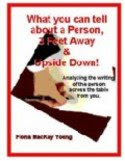As we start the new year off, it's hard to be optimistic with all the doom and gloom coming over the airwaves. However things will be no better just because you are feeling down, so why not try to look ahead with hope.
No matter how black things are, there is always hope and by seeking it out, you will feel better and go farther.
Optmism can become an intergral part of your signature very easily.
Any writing that goes "uphill" from left to right, or a t-bar that does the same, shows optimism.
It's a pretty easy thing to incorporate into your signature, or into all of your writing for that matter.
And it has the power to help you feel more optimistic for two reasons.
One is that handwriting is body language, and just like if you go around all day every day with a big smile on your face, laughing and being upbeat, you will start to feel that way genuinely, in that same way, writing with optimism in your signature will give you the same type of a lift. You will begin to feel the uplift of your upslanting signature.
And the other reason is for you doubters, who really can't believe that the previous paragraph is true.
You now know that upslanting writing is optimism, so any time you write that way you are going to register in your mind that you learnt that this is so. So it becomes similar to an affirmation in that every time you write with an upslanting signature, you think to yourself "optimism".
So it works because handwriting can change your attitude and your trait preferences, and it works because it becomes an affirmation every time you write that way.
So as of today, start writing your signature "uphill" and if you have any lower case "t"s in your name, give them an upslanting t-bar.
You have nothing to lose by doing so, and a great deal to gain.
Here's more
help on creating success for yourself in the coming year.So here's to an optimistic 2009.
.







